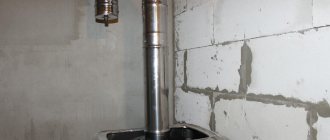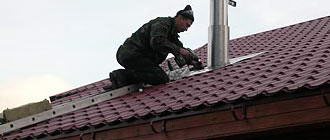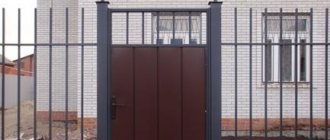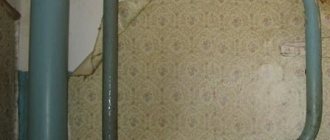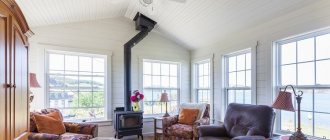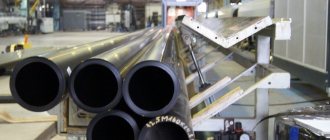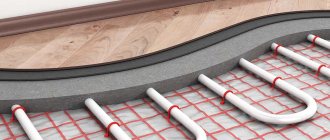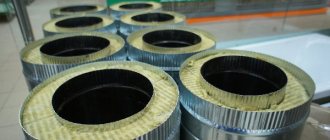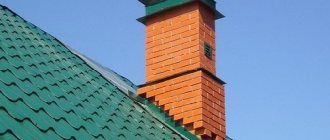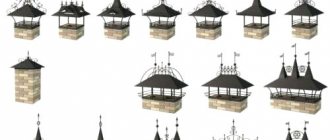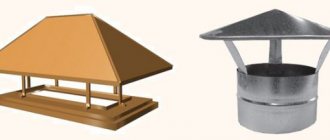Sealing gaps on tile roofs
This is the easiest way to seal gaps between a pipe and a slate or tile roof that you can do yourself.
To seal, you will need a moisture-resistant cement-based building mixture, a container for mixing the mortar, metal corners, a decorative collar and water. Sequence of work:
- The seam between the outer wall of the chimney and the roofing is lined with metal corners. If the pipe has a round shape, then a self-adhesive rubber seal is used for this purpose.
- A galvanized decorative collar is placed over the top of the pipe and secured with self-tapping screws.
- A waterproof solution is poured through the gap between the chimney and the collar and left for a day to harden.
- After the solution has completely hardened, an inclined surface is prepared from sheet steel for liquid drainage. To do this, cut a hole in the sheet corresponding to the diameter of the decorative collar, put it through the pipe and secure it with self-tapping screws at its base.
To seal the roof with a solution, it is necessary to use a high-quality waterproof mixture, otherwise, with the first serious rain, cracks will form through which moisture will enter the under-roof space.
What tools are needed for waterproofing work?
It is very important to remember the rule that ordinary silicone-based building sealants should never be used for waterproofing work. These materials do not have the necessary characteristics for insulating a chimney.
All necessary manipulations when waterproofing a chimney can be done using a set of tools, which includes:
- hacksaw;
- special brackets for installation;
- mineral wool;
- level and plumb;
- asbestos-based gasket;
- metal sheets;
- mastic;
- dowels;
- heat-resistant sealant;
- materials for thermal insulation;
- plaster mixture;
- work gloves.
Waterproofing a square chimney pipe
From a technological point of view, for the correct organization of work with your own hands, what is important is not the nature of the roofing material - metal tiles, ondulin, but the cross-section of the chimney - rectangular or round.
Waterproofing the chimney is carried out together with laying a waterproofing membrane on the roof.
- The film web in this area is cut so that the material overlaps the chimney. The film is glued to the walls of the chimney using polymer-bitumen mastic.
- A layer of bitumen mastic is again applied over the tightly pressed edges of the membrane. This waterproofing is already quite reliable, but is not very durable.
- A sheathing under the apron is fixed on top of the membrane - the second waterproofing element on the roof. The distance between the wall and the slats is 5–10 cm. It is recommended to treat the bars with fire retardants.
- An apron is installed around the chimney, starting from the bottom element. The apron is located 10–15 cm above the roof and covers an area of 20–30 cm around the perimeter of the chimney. Fastening - dowel-nails in increments of 15–20 cm.
- The joints between the elements and the chimney are treated with heat-resistant sealant.
- Then the roofing material is laid over the lower apron. Roof elements made of metal tiles or ondulin are laid end-to-end, making sure that the gaps are as small as possible.
If we are talking about a roof made of corrugated sheets, then a hole is formed in the sheet under the chimney with dimensions 1.5–2 cm smaller than the parameters of the chimney. Cuts are made in the corners of the hole, and the edges of the sheet are carefully folded back. At the stage of laying the roofing, this fragment is put on the chimney and the bent edges are aligned, trying to reduce the joints to a minimum. For waterproofing, a special device is used, such as bitumen waterproofing tape, or roofing felt and water-repellent sealant.
- A metal upper apron, similar to the lower one, is mounted on top of the roof made of corrugated sheets, metal tiles and other materials. You can use adhesive materials like Wakaflex, Master Flash, Onduflesh, etc.
In the photo you can see the installation of an apron around the stove chimney on the roof.
Waterproofing of a round chimney
This need arose due to the widespread use of sandwich pipes, which are very practical and more affordable. It’s even easier to do it yourself, since here the waterproofing is provided by a special device - pipe penetration.
The penetration looks like a box made of steel or aluminum with a cap made of polymer material.
- A wooden sheathing is installed around the chimney, just as was done in the previous case. Roofing material is laid.
- A hole with the required diameter is cut out in the flexible polymer part of the penetration. The device is put on the pipe and pressed against the roofing material.
- The joints are treated with a special heat-resistant sealant. The penetration is secured with self-tapping screws to the sheathing in increments of 7–10 cm.
The video discusses the waterproofing of round and rectangular pipes.
Chimney fire protection
Today, ready-made “sandwich” panels made of steel or ceramics are available for sale. Their installation proceeds as follows:
- To install a modular system, an asbestos gasket is installed between the stove and the chimney.
- Then a layer of solution is applied on which the module is placed. Level, and secure subsequent blocks with a layer of mortar.
- The places where the smoke device passes through the roof are well insulated. Fire-resistant insulation of the roof will be provided by a galvanized steel box, secured with staples to the rafters and cross beams at the point where the pipe passes.
Pipe waterproofing
Quick and reliable protection of the chimney from leakage is carried out by applying roll materials.
Main stages of installation work:
- The pipe is coated with a primer and covered with a superdiffusion membrane. Instead of a primer, it is possible to use polymer-bitumen mastic. The membrane is glued to the roof, the edges are placed on the pipe.
- The top and bottom ties are made from metal. The bars are stuffed onto the sheathing and the corners are secured.
- The rolled material is laid overlapping, allowing for proper water drainage on a soft or metal roof. The length of the bottom sheet reaches the roof overhang.
- The joints are insulated with bitumen mastic. The corners are secured to the sheathing with dowels. The cracks are treated with heat-resistant sealant.
- The roofing decking is laid, a PVC apron is placed on top using Onduflesh tape, and the sealing is completed.
Device for connecting the roof to the pipe
Fixing a roof leak near a pipe
There is a leaking pipe on the roof of the house - bitumen tape, a polymer cap or a tin apron will solve the problem.
What types of sealants are best to use for chimney pipes? characteristics
The chimney is one of the most important communications in residential buildings, the efficiency of which largely determines the ability to live in the house. However, in order for the functioning of smoke structures to be effective and safe, simply installing them is not enough - it is also necessary to ensure the tightness of the structure.
During the operation of the chimney, the very high temperature that occurs inside it (1300 °C) contributes to the formation of various cracks and fistulas in the structure. This significantly reduces draft and allows toxic combustion products to penetrate into the room. Therefore, the need to ensure the tightness of chimneys becomes vital.
The need for repair and sealing sooner or later arises even for expensive and high-quality pipe products, for example, galvanized or made of stainless steel. In order for sealing to be effective and long-term, you should use high-quality and reliable sealant for chimney pipes for this purpose.
Important points
The waterproofing of chimneys, if it is damaged, can be restored in several ways: the choice of the most suitable one depends on several factors:
- A pipe installed on a slate roof must be freed from the cement apron, and then the slate sheets adjacent to the pipe must be removed. After checking the condition of the pipe for mechanical damage, an apron should be made from sheet metal. The joints are treated with oven clay with the addition of Portland cement or fire-resistant mastic. Now you can lay slate sheets on the apron, and then coat them with cement mortar.
- Fused insulation can be used to insulate leaky areas, but damaged slate sheets should also be replaced.
- If the pipe is made of brick and the first two above points are completed, it is enough to coat it with clay-cement mortar.
- For a metal roof, you need an apron made of the same material: it can be made using special scissors. The outlets of round pipes can be sealed using special corrugated rubber elements.
- If the distance between the pipe and the ridge is large, special bitumen tapes with metal inserts are used.
The exit points of round pipes are sealed using rubber corrugated inserts
How to avoid leaks
If everything is done correctly, there should be no leaks.
However, various unpleasant accidents can happen that break the tightness of the insulation.
The solution to the issue will be to detect the location of the leak and additional insulation using sealant , Wakaflex or other materials suitable for this purpose.
Specific decisions are made based on precise knowledge of the location of the leak and the material in which the hole or gap is found. For round pipes, pipe penetrations are sold that cover the joint using a corrugated rubber cone.
If you don't seal the joint
When removing the chimney, a hole is made in the roof. The gap between the coating and the walls of the chimney is sealed with special aprons, collars and seals. They can be bought at any hardware store. These protective elements are easy to make with your own hands.
If you do not seal the seams on the roof in time, the following consequences are possible:
- Increased wear of roofing material. Water penetrating into the gap ends up on the inner surface of the roof, which causes deformation of the coating.
- Reduced service life of the building frame. Water that is poured into the gap between the pipe and the roofing contributes to the gradual rotting of the wood. This is fraught with deformation and destruction of the rafters.
- The insulation loses its effectiveness. Thermal insulating materials with which the roof is equipped can quickly lose their properties when wet. If hard insulation is not very exposed to moisture, then soft insulation quickly begins to rot.
- Increased humidity in the attic. Increased dampness causes stale, heavy air to appear. This can negatively affect the interior decoration of the attic.
The method for eliminating the gap between the pipe and the roof depends on its size and type of coating. The shape of the chimney is also taken into account. For a distance of less than 5 mm, use a heat-resistant sealant. If the gap width exceeds 1 cm, use cement mortar, an apron or a special sealant.
It is necessary to seal the gap between the pipe and the roof for:
- ensuring insulation of the attic space from atmospheric moisture;
- to increase the efficiency of thermal and waterproofing;
- increasing the service life of the rafter system and the entire roofing structure;
- eliminating cold bridges.
Sealing the chimney on the roof avoids destruction of the roof itself.
Sealing a rectangular pipe
Rectangular pipes are the most common. They are used as a chimney or ventilation duct. Ceramic blocks or heat-resistant bricks are used for their manufacture. The finishing of the junction of the corrugated sheet and the rectangular pipe is done using an apron, which is a ready-made shaped element. For its manufacture, galvanized steel is used, painted in the same color as the roofing.
The process of sealing a joint using an apron consists of the following steps:
- Vapor barrier and waterproofing material, cut when the chimney is brought out, is glued to the outer walls of the rectangular pipe. Construction tape is used for these purposes.
- Make a shallow groove around the perimeter of the pipe using an angle grinder. The groove is needed to install the top strip.
- The upper edge of the plank is placed into the groove made. To create additional fixation, heat-resistant silicone sealant is used.
- Place the lower part of the apron with an overlap of 10 to 15 cm. Fixation is carried out with self-tapping screws for corrugated sheets.
- Under the lower part of the apron there is a tie made of waterproofing material. This element prevents leaks in the roof.
It is desirable that the additional elements used to finish the joint between the corrugated sheet and the rectangular pipe are made of the same material and the same color as the roof covering. The easiest way to install an apron is that it is manufactured by the same company as the profiled sheets used. Then the sealing of the pipe on the roof will be of high quality.
Tape sealant
Tape sealant is a solid material. Many builders consider it the most cost-effective option for roof sealing. Material Features:
- it is based on butyl rubber;
- The sealant tape is highly resistant to ultraviolet radiation and high temperatures;
- it has high adhesiveness, making it easy to install;
- Ideal for sealing joints between chimneys and roofing.
The tape has an aluminum coating, which increases the service life of the sealant for outdoor use. The tape is easy to install and operate. The average service life of the product is 10 years. Thanks to a wide range of colors, the tape can be used to seal various roofing coverings. The sealant has exceptional adhesion to various surfaces. The tape is used when it is necessary to seal wooden, plastic, and metal surfaces. The tape is also successfully used for sealing translucent roofs.
How to use
The surface of the pipe and roof on which the tape is applied must be cleaned and dried
It is important that the area being treated is level. To apply the tape, you need to cut a piece of a certain length, then remove the protective film and press the product tightly against the joint (slot)
At temperatures below +5, the tape is first kept indoors at a temperature of 15 degrees for 12 hours.
Using the tape in sub-zero temperatures involves heating the surface to be treated. The tape is not used for surfaces with an operating temperature above 80 degrees or when the roof slope is more than 55 degrees.
Wakaflex material laying technology
Vakaflex is a self-adhesive plastic waterproofing tape. Vakaflex has internal reinforcement with aluminum, thanks to which it can take the shape of the roofing profile while simultaneously adhering to the pipe. Installation of Wakaflex is simple and can be done by one person.
- The tape begins to be glued along the lower edge of the pipe. Cut it along the length of the wall with a margin of three to five cm on each side. Bend it in half lengthwise, remove the protective layer from the upper half and glue the tape to the pipe, rolling it with a hard roller. Then remove the bottom protective film and glue it to the roofing, carefully rolling it with a roller until a complete fit is ensured. The corners of the tape are carefully trimmed, folded onto the side walls of the pipe and glued.
A Waka strip is attached to the pipe over the waterproofing tape, preventing water from flowing along the plane of the pipe.
Sealing seams on a corrugated roof
Work sequences:
- L-shaped junction strips are applied to the chimney and lines are drawn on its walls along the upper edge of the strips;
- using this marking, an angle grinder with a stone disc makes grooves 10-15 mm deep;
- The lower abutment strip is installed first, while the bend in its upper part is inserted into the groove;
- then the side strips are installed in the same way with an overlap on the bottom and lastly the top.
The grooves are filled with heat-resistant silicone sealant, and the lower horizontal parts of the planks are fixed with self-tapping screws to the sheathing. To prevent leakage at fastening points, it is necessary to use special roofing screws with rubberized heads. If you don’t have these, you can cut gaskets out of rubber and put them on a self-tapping screw under the head.
At the final stage, a so-called tie made of waterproof material is installed so that water flows into the drainage system of the house. Corrugated sheeting is laid on top of the structure, another decorative false apron is installed and fixed to the pipe with self-tapping screws.
When sealing in this way, you can do without cutting the grooves, but for this you need to lay out a pipe with a protrusion under which the abutment strips will be inserted.
Many furnaces are equipped with round pipes consisting of several layers. To seal the seams around such a pipe, ready-made caps with an apron are produced. They are a galvanized sheet with a hole to which a cone is attached at an angle. The sheet is fixed with self-tapping screws on the sheathing, the pipe is inserted through the hole in the cap. The upper part of the cone is pressed around the pipe with a metal clamp with a gasket, ensuring a tight connection.
In addition to rigid caps, Master Flash elastic penetrations are available for sale, allowing you to seal the seam near the pipe quickly and efficiently. They can be used not only to seal chimneys, but also other roof elements - antennas, ventilation pipes. In appearance, Master Flash is similar to a metal cap, only it is made of rubber or silicone. It can be used at temperatures from – 50°C to 130°C on any type of coating, and is especially suitable for use on translucent roofs.
Installation of flexible penetration is not difficult at all. A hole is cut at its base slightly smaller than the diameter of the chimney. The penetration is simply pulled onto the pipe, the base around the perimeter is coated with heat-resistant silicone sealant and fixed to the corrugated sheet with roofing screws. You can additionally glue the junction of the base and roof with self-adhesive tape. To protect the penetration from ultraviolet radiation, a decorative cap is placed on top of it to match the color of the roofing.
Sealing round multi-layer chimneys
It is much easier to install sealing on modern round chimneys. The simplicity of the process is due to the fact that no additional equipment is required, since the pipe is already equipped with everything necessary. Installation takes place in three stages:
- Prime the edge of the pipe where the waterproofing will be attached.
- Make a hole in the waterproofing, then glue it to the pipe using mastic.
- The sheet must be attached to the sheathing. The pipe is passed through a cap, between which a clamp with a heat-resistant gasket must be located.
Round metal chimneys Source pinterest.com
If there are no caps, then flexible elastic seals for pipes are used instead. The sealant can also be used anywhere else where roof insulation needs to be improved.
How to protect a chimney from moisture
Practice shows that most often water leaks on the roof near the pipe are associated with poor-quality sealing of the roof section. If the cutting is under the roof, it will leak from below, if on top, it will leak from above. To prevent this, the chimney on the roof is waterproofed by installing insulating aprons.
The work is carried out in several stages:
- First of all, a drainage gutter is placed in the waterproofing layer above the chimney, designed to remove moisture from the chimney.
- Then an internal apron is installed, ensuring complete sealing of the junction of the roofing covering and the chimney.
- Next, the so-called “tie” is laid. This is an element cut from waterproofing material, placed under the lower edge of the inner apron. The structure must reach the very edge of the roof. If the roof is covered with slate or metal tiles, the edge of the tie is brought out between the lower sheets of covering onto the roof surface. Along the edges of the structure, be sure to make a side with the help of pliers, which will prevent water from spreading over the roof, but will direct it down the slope.
- A roof covering is laid around the pipe.
- An external decorative apron is mounted on top of the roof. It is installed in the same way as the internal one. The only difference is that the top edge is fixed directly to the pipe wall.
Sealing the chimney with roofing felt and installing an “apron”
Insulating aprons are made independently, but if desired, you can purchase industrially manufactured units designed specifically for these purposes. They are used for wiring circular chimneys through the roof and are called roof passages. The nodes are an element consisting of a flat sheet of steel in the form of a base, to which an apron made in the form of a cap is attached. A chimney runs inside it.
Roofing penetrations are available in different colors to make it easier to choose the right option
To ensure stove draft, it is necessary to install ventilation outlets on the roof. They form air flows, protect ventilation from precipitation and create draft in heating devices. The outlets must be fixed strictly vertically and be equal in height to the chimney; only in this case the air flows generated in them will be strong enough to ensure optimal combustion of fuel in the heating device.
Waterproofing a pipe is a responsible undertaking. Not only the integrity of the roofing pie, but also the safety of using heating devices depends on the correctness of its implementation. Of course, you can do all the work yourself, but you need to calculate your strength and be sure that everything will be installed absolutely correctly. If you still have doubts about your competence, it is better to entrust the installation of waterproofing to specialists and receive a unit mounted in accordance with all the rules in a short time.
Adjacent rules
Construction norms SNiP do not have strict regulations on the location of the chimney, but contain instructions on the height of this element:
- The height of the chimney must exceed the height of the ridge by at least 0.5 meters, if it is located at a distance of 150 cm or less from the ridge itself;
- When located 1.5 - 3 m from the ridge, the chimney pipe can be equal in height to the level of the ridge or exceed it;
- If the distance from the ridge to the pipe exceeds 300 cm, then its height should be at the same level as the ridge, or not lower than a line drawn from the ridge at an angle of 10 degrees to the horizon line.
All other implementation features required by the device connecting the roof to the pipe remain without regulatory recommendations, and therefore can be carried out at your own discretion.
But taking into account the experience of professionals, it is better to install the pipe on the roof closer to the ridge, for the following reasons:
- This arrangement facilitates the process of high-quality sealing and provides coverage without leaks;
- The closer the pipe is to the ridge, the less space is left for snow and water to accumulate behind it, reducing the risk of leaks.
Attention! Condensation can form both inside and on the surface of the pipe, which leads to the formation of ice during the cold season. It damages the walls of the chimney, significantly impairing draft and reducing service life.
Round pipe
A roof equipped with a round chimney is one of the most common options for private construction.
To ensure a high-quality connection to the roof of such a pipe, standard three-layer structures are produced. The central part of such a multilayer system is made of heat-insulating material. The kit is complemented by a flat steel sheet and an apron-cap into which the chimney pipe is inserted.
It is worth choosing a suitable kit depending on the angle of inclination of the slope. Standard systems are produced for the most common angles. With the help of such structures, making your own high-quality connection is quite simple.
The abutment plate is tightly and rigidly secured to the roof plane. The top of the cap is cut off; the size of the cut should allow the pipe to fit tightly into the hole, with no gaps. The upper edge of the apron is pressed against the pipe with a steel clamp with a gasket made of heat-resistant elastic material.
Attention! All materials must be reasonably clean, as well as the roof surface. This will ensure maximum quality of sealing work. The plate is secured with self-tapping screws, using rubber or neoprene gaskets.
The plate is secured with self-tapping screws, using rubber or neoprene gaskets.
If the angle of the slope does not allow the use of a standard type chimney installation system, then this can be done without the involvement of specialists. To do this, to create a sealed apron, it is necessary to cover the perimeter of the pipe with lead or aluminum tape.
It is also possible to use a finished oval-shaped lead part, which can be easily profiled onto the covering of a soft roof or a roof made of hard material using a rubber hammer or a wooden tool.
This lead self-adhesive is a material with high performance properties. It is resistant to temperature fluctuations, corrosion and ultraviolet radiation.
One of the ways to independently seal a round pipe on a metal roof is shown in the video:
Square pipe
For the installation of square and rectangular pipes, it is very rarely possible to select ideally suitable ready-made elements offered for sale. Depending on the type of roofing material, methods for arranging the connection of the pipe to the roof are also selected.
Roof passage unit
When carrying out construction work, partial dismantling of the roof sheathing is often required. At the same time, to ensure the rigidity of the structure, a frame made of wooden beams is mounted around the pipe, to which layers of waterproofing and vapor barrier are attached. The waterproofing is attached to the sheathing and counter-lattice. The vapor barrier is installed between the roof frame and the interior finishing materials. The space between the frame and the pipe must be filled, according to SNiP standards, with thermal insulating non-combustible material - stone wool.
Important! Particular attention should be paid to the quality of sealing of the joint between the vertical element and the roofing material. There should be no leaks at their connection points.
Deciding on the type of waterproofing material
The development of chemical production makes it possible today to produce a large number of insulating materials for roof carpets. What type of material should I choose: roll, liquid, powder? What composition should it have in order to long-term and reliably protect the house from water penetration under the roof, especially in places where pipes exit onto it?
Waterproofing of pipes along with the base of flat roofs is carried out using liquid reinforced mastics - mixtures of organic binders with extremely crushed fillers. The composition of such mastics is very different, most often they are hot or cold bitumen-gasoline mixtures. Today, more and more often on the market there are branded liquid or powder mastics, intended for subsequent dilution with solvents, with a complex multi-component composition.
Treating the pipe with mastic
On pitched roofs, roll mastics, film and non-woven materials are used, which are also glued to the base using mastics or fastened with self-tapping screws. The well-known roofing material is one of the roll mastics. A special film, polyethylene and polypropylene, or non-woven synthetic membranes can be used as a material for waterproofing. Roll waterproofing has many modifications, allowing you to specifically select the one that will most fully meet the functions of a particular roof.
Special film is used quite often today as a waterproofing material.
The quality of roof waterproofing work depends to a large extent on whether the joints formed by the pipes exiting to its surface are executed correctly or not. It is these areas that often reveal the unprofessionalism of the builders. Based on the foregoing, one should conclude: contacting specialists at the stage of waterproofing pipes and any exits to the roof will help to avoid unnecessary financial and labor costs in the future.
Why is waterproofing needed?
Waterproofing a chimney is primarily a protective measure that prevents roof leaks. In addition, insulation, in principle, must be present in accordance with fire regulations; it performs a safety function, preventing possible ignition of roof elements that are directly adjacent to the pipe.
Waterproofing the chimney also increases the overall performance of the stove heating system. Without insulation, condensate usually flows down the walls of the pipe, which is a gross violation of standards and generally an undesirable phenomenon. Among other things, condensate evaporates when the furnace is heated and thus creates an increased pressure in the pipe, which affects normal draft. Because of this, the quality of heating decreases. Over time, increased pressure in the stove can cause destruction of the chimney (especially if the walls of the chimney have cracks).
Another extremely negative factor for a chimney is the chemical compounds that are formed during the combustion of heating materials. As a result of exposure to high temperatures and moisture, which condenses due to improper insulation of the chimney, a chemical process occurs in the formation of active substances (alkali, acids, salts). These compounds “embed” into the pipe walls and destroy them.
Note! A very important point is that the formation and accumulation of condensation in the pipe can cause smoke in the heated room.
Waterproofing is necessary for brick pipes and ducts, as moisture quickly destroys the masonry
With the correct placement of the pipe on the roof of the building, the complexity of insulation work is minimized. To do this, you must first select a location for the pipe and carry out the necessary calculations before installing it. The longer and smoother the chimney, the better its efficiency. As a rule, the best option for installing a chimney is considered to be the place of the slope next to the ridge. Thanks to this placement of the chimney on the roof, the formation of snow pockets can be prevented in winter. With this arrangement of the chimney, the roof is insulated at the exit point of the duct.
We cover the chimney with corrugated sheeting
The priority of autonomous heating of a private home is increasingly obvious. In addition to significant savings, this is the opportunity to independently choose alternative heating methods. Among the sufficient number of available options, stove heating is still popular. Despite certain installation difficulties, this is the best way to create a favorable microclimate in the house.
Any autonomous heating, with the exception of electricity, requires the removal of combustion products through a chimney. Today there are enough materials with which it can be organized. If it is a fire-resistant brick, it is most advisable to protect it from the negative effects of aggressive environmental factors by means of cladding.
Attention. Our readers think that morning fishing is a myth! The secret of the catch has been revealed, you just need to dissolve 1 sachet in 0.5 liters of water read more
The chimney lining is a kind of shield that prevents the formation of condensation as a result of the interaction of the difference in ambient temperatures and the chimney pipe.
Heat-resistant chimney sealants
This type of sealing material has a silicone base to which iron oxides are added. Such additives not only increase the temperature resistance of the sealant, but also give it a reddish tint, which makes the composition invisible when processing brick chimneys.
When using heat-resistant silicone sealants, a number of their important features should be taken into account, in particular:
- Such materials may release acetic acid, promoting an acid reaction. This is the reason that they cannot be used for metal chimneys.
- Some types of heat-resistant sealants are not resistant to solar radiation, which limits their use for roof structures.
- Good adhesion to many substances and materials (brick, ceramics, glass, concrete, etc.) makes their scope of application quite wide.
- Due to their high water resistance, they can be used to seal the upper sections of chimney structures.
- They have good ductility and strength, as a result of which they can be used in structures experiencing significant wind loads.
- The hardening process of silicone sealants takes from several hours to several days, and depends on the temperature and humidity of the environment. The optimal values for these indicators are 25 °C and 50%.
- It is not recommended to use silicone sealants for deep seams or cracks.
- To improve the quality of sealing, before applying the composition, the surfaces of the seams should be cleaned of dust, dirt, grease deposits and other debris.
- Silicone sealants can only be applied to completely dry surfaces.
- Conventional silicone sealants used in construction are not heat-resistant and cannot be used to seal chimney structures.
Waterproofing materials
film materials as a cutoff , as they are the easiest to install and most effective in operation. There are polyethylene films, membranes with one-way vapor transmission, single- and multi-layer membranes with combined action, etc. There are many options for choosing film materials, the difference between them lies in the area of technical characteristics. The installation and conditions for normal operation are similar.
IMPORTANT!
In addition to film materials, coloring compositions are used, for example, bitumen mastics . Application to the surface is carried out with a hard brush, mop, etc. The advantage of this material is the ability to create a layer of arbitrary thickness. The coating is continuous, without gaps or cracks. This article provides a detailed overview of waterproofing materials.
The disadvantages include the inconvenience of application when insulating the roof from the inside; some brands of mastic require heating to operating temperature, which is difficult in an attic.
Pasting materials are also used, which are stuck to the applied layer of a binder, for example, bitumen mastic. Until recently, this option was the most common, but this method is inconvenient for insulating the under-roof space.
Simplicity, reliability in operation and a huge range have made films and membranes . The effect of their use does not change over time, the films are elastic and can withstand slight deformations, which other materials cannot tolerate. Therefore, the most preferable option today is waterproofing films .
Chimney finishing, choice of materials
Negative factors affecting the chimney include
:
- atmospheric influences (wind, precipitation, ultraviolet radiation);
- difference in ambient temperatures;
- high temperature operating loads.
Due to the difference between the temperature of the working pipe and the air temperature in the chimney, condensation forms, which provokes destruction of the pipe during the combustion of heating oil
. To avoid the formation of condensation and protect the pipe from external influences, it is necessary to provide reliable insulation of the chimney through lining.
Various materials are used to cover the protruding part of the pipe. When choosing, you should consider
:
- resistance to external factors, wear resistance;
- appearance and color scheme (matching the roofing or wall decoration of the building).
Finishing a chimney on the roof is most often done using
:
- clinker bricks or tiles;
- plasters;
- cement fiber boards;
- roofing material (corrugated sheeting, slate).
Characteristics of finishing materials
Clinker bricks or tiles are a practical option for finishing a chimney pipe, since dirt is not noticeable on such material.
The advantages of clinker materials also include the aesthetics of the masonry; such a chimney goes well with any type of roofing. It is worth noting the resistance of tiles and bricks to weather conditions, temperature changes, as well as the strength of the material. For lining the chimney, exclusively solid clinker bricks are used, laid on a clinker mortar; special compounds are used for grouting joints. Thin, lightweight clinker tiles are usually used for lining tall pipes. Finishing a chimney on the roof with plaster is characterized by
:
- affordable cost;
- simple installation;
- versatility (suitable for any roofing);
- the ability to implement any color schemes (plaster can be painted with silicone paint).
Plastering pipes is carried out using the same technology as finishing facade walls. Traditional cement or lime-cement mortar can be used, but a more durable option is to use mineral, silicone, silicate or acrylic plaster. Painting the dried surface increases the wear resistance and durability of the finish.
Small-format cement-fiber boards are durable, resistant to ultraviolet radiation, moisture, temperature fluctuations, and light in weight. This is an environmentally friendly, non-flammable material. Smooth or structured slabs can be used for lining the chimney; the material is available for sale in a wide range of colors.
If slate is used for roofing, the chimney lining on the roof is usually made of the same material. Slate slabs can be shaped like an arc, flake, rectangle or octagon. The color of this natural material depends on the deposit. This color is usually graphite, green or purple.
A fairly simple and inexpensive option for finishing a pipe is to use corrugated sheeting. It is used if the roof covering is made of the same material. The pipe, finished in the color of the roof, looks aesthetically attractive.
Manufactured in a factory, the chimney elements for the roof passage have an aesthetic appearance and are quite easy to install. They are equipped with a steel chimney duct and can have a ready-made external cladding made of any material, or be prepared for independent finishing so that the chimney is externally in harmony with the roof. The modular steel structure is not additionally finished; it is enough to install it at the point of passage through the roofing pie.
How to seal the gaps between the pipe and slate
Slate is the most affordable roofing material available. Therefore, solutions for sealing the gap between the pipe and the roof should also be cheap, as well as simple and quick to implement.
So, if you are looking for something to seal the gap between the chimney and the slate roof, then asbestos mortar is best suited for this purpose. If you need a more technologically advanced and durable method of sealing the joint, then place a steel apron on the pipe.
Mortar of cement with asbestos
Sealing a pipe on a slate roof with a mixture of cement and asbestos is a makeshift, but no less effective method. After all, it is not for nothing that asbestos continues to be used to create fire-resistant coatings and materials, despite its tarnished reputation.
The method itself is simple: asbestos soaked in water is mixed with cement and the resulting solution is used to cover the joints between the chimney pipe and the slate. The main thing is not to forget about latex gloves and a respirator. Still, the reputation of this material is spoiled for a reason - it is classified as a first-degree carcinogen, that is, it reliably causes cancer. And asbestos is especially dangerous if it gets into the lungs. However, if you follow simple safety measures, the risk is almost zero.
Now we’ll tell you step by step how to seal the gap between the pipe and the roof with asbestos mortar:
- Asbestos is soaked in water in a ratio of 1 to 1. It is better if the asbestos is in the form of fibers or powder, but crushed asbestos sheets can also be used.
- Soaked asbestos in a ratio of 1 to 1 is mixed with M400 cement.
- Before covering the pipe on the roof, the slate around it and 100-150 mm of the chimney are thoroughly cleaned of dirt and degreased.
- The resulting solution is used to cover the gap between the pipe and the slate. Everything is standard on the bottom and sides: the solution should extend slightly onto the pipe in order to better adhere to it. But at the back you need to fashion a small hump from the mixture with a sharp “ridge” in the center and smooth slopes. This is necessary so that the snow does not accumulate behind the pipe, but appears to be cut and slides down the sides.
- With hands dipped in water, smooth out the solution so that there are no ledges or roughness that could interfere with water drainage or snow removal.
Asbestos mortar is very cheap and can easily withstand temperatures of more than 1000 °C, so it can be used to cover the gap between the pipe and the roof of the bathhouse without fear that the mixture will crack due to heating. In addition, asbestos mortar has excellent adhesion to slate and is resistant to caustic substances and temperature changes. But it has three main disadvantages.
Firstly, the joint between the pipe and the roof should not be very wide. Otherwise, when puttying, the mixture will simply fall through the gap. Even if you manage to hammer a wide gap, the solution will begin to crumble over time, which will lead to leakage.
Secondly, the solution stuck to the pipe looks ugly. If we are talking about a bathhouse or an outbuilding, then this may not matter, but sealing a chimney on the roof of a house is a completely different matter.
Thirdly, the knot is not very reliable. A small mistake in mixing the solution or applying it is enough for the roof to leak at the first rain. But even if the technology is followed, the service life of the connection is unlikely to exceed 15 years. Again, this is acceptable for a bathhouse, but not for the roof of the main house.
Apron made of galvanized metal or stainless steel
Another inexpensive way to seal the gap between a slate roof and a round chimney. However, unlike asbestos mortar, this method is suitable for all types of non-metallic roofing.
A steel apron or pipe penetration is a base made of a flat steel sheet to which a cone with a cut off top is welded. The cone is placed on a round chimney and sealed, and the base is attached to the roofing. The result is a reliable and durable unit, which, if installed correctly, can maintain tightness for decades.
Sealing a roof pipe with a steel flashing is done in seven steps:
- The slate and pipe are cleaned of contaminants and, if the roofing pie with insulation has not yet been installed, washed with a stream of water.
- An apron is placed on the pipe so that the base is pressed tightly against the roofing and goes under the ridge. If the pipe outlet is far from the ridge, then the steel sheet is increased to bring its upper edge under the ridge strip by at least 60 mm. This must be done, otherwise the joint between the pipe and the roof will leak, no matter how much sealant you use.
- The base is screwed to the sheathing using roofing screws with an EPDM rubber gasket to protect the joints from leaks. For the same reason, screws are screwed into the top of the wave. Before screwing in the screws, it is necessary to drill holes in the slate so that it does not crack.
- The side edges of the base of the apron are bent with a mallet so that they fit snugly against the slate and coated with polyurethane or silicone sealant.
- A clamp is installed on the pipe and clamped at the transition point between the apron and the chimney.
- The clamp is carefully sealed. For better protection, you can place a collar with a “skirt” close to the clamp, which will cut off water from the connection.
- A sealant is placed or foam is blown into the holes formed between the base and the slate waves.
Waterproofing a chimney on the roof
When making a passage through the roof, it is important to comply with SNiP standards. A gap should be left between the roof elements and the chimney, the size of which is regulated by documents
At the point of passage through the roof, a box (wooden or galvanized metal) is usually installed, in which all the free space around the pipe is filled with non-combustible material - stone or glass wool.
Sealing a chimney on the roof can be done using improvised means or using standardized elements. Around the chimney you should make a so-called collar, or flashing - a trim made of strips of metal, about 40 cm wide, in accordance with the dimensions of the pipe. The bend angle of the steel strips must correspond to the angle of passage of the chimney pipe through the roof. To calculate the length of the section, you need to take into account
:
- slope angle;
- chimney dimensions;
- chimney finishing type.
If the flashings are made of galvanized sheets, then they are interconnected with an overlay and soldered. Elements made of sheet steel are connected by a double standing seam. The rebated seam connection is used to seal the passageway on roofs made of corrugated slabs and tiles. If the roof slope angle is more than 30 degrees, a special beam should be installed behind the chimney - a “bumper”, which will protect the pipe from rainwater flows and excessive snow pressure in winter
.
A protective elastic apron for a chimney can be made
:
- from flexible metal tape (lead or aluminum);
- made of galvanized metal with polymer coating.
The apron is installed around the pipe in two layers around the entire perimeter. The bottom layer of the apron is placed under the roofing, and the top layer is mounted on top of the roofing material. To cover the top layer of the apron, a waterproofing film and metal profiles are used.
The top curved edge of each apron should fit into a groove cut around the perimeter of the chimney. After installing the edge into the groove, the joint is filled with polymer sealant or silicone for roofing.
Ready solutions
Sealing a chimney on the roof is a rather complex task, the quality of the solution of which determines the reliability of the thermal and waterproofing of the roof. You can make the passage assembly yourself, using various materials and special strips, or mount a ready-made structure, which includes a wide protective apron.
Ready-made roof cutting on the construction market is presented in many versions - models differ in material and manufacturing method, as well as the angle of inclination of the element that protects the place where the pipe passes through the roofing pie from water. The angle of inclination can be from 15 to 55 degrees, therefore, the cutting of the chimney on the roof is designed for the most common slope options.
To install such a structure, a hole of appropriate dimensions is made in the roofing pie. A seal made of rubber is attached to the outside of the structure using silicone. The distance between the pipe and the collection passage is filled with non-combustible insulation. The roofing penetration covers the passage unit, after which the penetration can be attached to the roof with self-tapping screws. To ensure a tight connection, it is recommended to use a sealant.
When choosing the option of how to seal a chimney on the roof, you can use other ready-made solutions, for example, Master flash roofing penetrations.
https://youtube.com/watch?v=rL-_Irakk4s
Repairing leaks near a pipe
If water flows through the chimney during snow melting or rain, the reason for this is a violation of the tightness in the place where the pipe and the roof are connected. If there is a roof leak near a pipe, there are a number of ways to fix the existing problem:
- apply bitumen tape;
- install rubber cuffs;
- make and install a metal apron.
All of the above methods allow you to close the leak, so they should be considered in more detail.
Using bitumen tape
If a chimney leaks due to rain or melting snow, then the simplest and cheapest way to eliminate the leak is to make an apron from bitumen tape. To perform such work you need to use the following materials and tools:
- bitumen tape;
- scissors;
- metal brush;
- gas burner.
The cracks are sealed by taking the following measures:
- first you need to use a metal brush, which is used to clean the roof around the chimney and its outer lower part;
- Remove any remaining dust and dirt with a damp cloth;
- At the junction of the pipe and the roofing material, pieces of bitumen tape are glued. It doesn't matter which side the gaps are on. You should create a full apron around the entire pipe;
- the glued tape is heated with a gas burner, which is pressed as tightly as possible to the roof and pipe;
- to seal the joint more reliably, the tape can be additionally secured with a wooden block or board (this cannot always be done, it all depends on the roofing material).
Bitumen tape is a universal material. It can be used if a pipe or roof made of any materials is leaking. The tape is capable of performing its functions efficiently for 2-3 years (depending on the amount of precipitation and other factors).
Using the rubber cuff
If the roof is leaking near the chimney duct, then this situation can be corrected by using a rubber cuff, which can be purchased at almost any hardware store. It is installed as follows:
- a cutout is made in the upper part of the cuff, the diameter of which is slightly less than the thickness of the pipe;
- the prepared cuff is put on the outer part of the chimney duct and lowered to the roof level;
- To avoid the possibility of repeated leakage, it is necessary to use sealant at the point where the roof comes into contact with the lower part of the cuff.
Some types of cuffs are not easily glued to the roof. Some models can be screwed to the roof with self-tapping screws, but this is only possible in cases where the roof is not made of tiles or slate.
The main disadvantage of the rubber collar is that it cannot be installed on a square or rectangular pipe. What to do in such a situation? Use any other leak repair method described above and below.
Arranging a metal apron
A chimney leak at the junction of the pipe and the roof can be eliminated by installing a metal apron. This is done as follows:
- An apron is made from a thin sheet of tin, the dimensions of which must match the dimensions of the pipe. A similar product can be purchased at a hardware store;
- the upper part of the apron is attached to the pipe and crimped using a clamp. The crimping process must be carried out carefully. Gaps are not allowed;
- The lower part of the apron is installed on the roof and secured with self-tapping screws. To ensure that the damaged area of the roof does not leak, in the future the lower part of the plate should be secured on top of the roofing material, and the upper part should be removed under the sheathing.
At this point, the manufacture and installation of the metal apron can be considered complete. The sealed area will no longer cause problems. For additional sealing, the metal apron can be equipped with a rubber lining, and the contact point between the cone-shaped part and the chimney duct can be sealed with sealant.
A leaking roof near a chimney can be repaired in many ways. Such cracks are closed in 5-10 minutes, but it is worth understanding that such repairs cannot be considered high-quality. The sealed joints between the roof and vertical elements will certainly make themselves felt in a few years. Thus, such local repairs are a temporary measure. It is designed to protect against moisture entering the room until a full roofing repair is completed.
Possible problems with poor-quality sealing of the roof passage
Corrugated sheeting is a high-quality roofing material that has a complex layered structure. The following layers are applied to the outer steel sheet base:
- zinc;
- additional anti-corrosion;
- primers;
- polymer (polyester);
- installation protection.
And on the inside, galvanization, primer and corrosion protection are also applied. Thanks to this structure, corrugated sheeting has excellent load-bearing capacity, protection from rust, fire and rot. The building material retains its properties over a wide temperature range.
It is customary to create various openings on the roofs of houses for ventilation and smoke escape. This naturally leads to damage to the waterproofing and other protective layers. Therefore, sealing the joints between the pipe and the roof surface is of great importance. This process must be carried out correctly, otherwise problems may arise:
- Leak. When the pipe is routed through the roof, the presence of uninsulated cracks leads to the penetration of water into the house, living quarters, dampness of the walls, including load-bearing ones, the appearance of mold, etc.
- Destruction of rafters. The roof structure consists of wooden rafters. Moisture entering through the joints contributes to the rotting of the wood and the destruction of the entire structure.
- Corrugated sheeting corrosion. Although the roofing material is protected by anti-corrosion layers, the internal protection is weaker than the outer layer. Corrosion gradually destroys corrugated sheeting, reducing its protective characteristics and attractive appearance.
- Reduced roof insulation level. When water penetrates into the layers of thermal insulation, the latter lose their ability to retain heat and protect from external cold. The insulator loses about 50% of its ability to effectively retain warm air in residential areas.
To be sure of the quality of your roof, you should seal the joints in a high-quality manner. Various sealing methods have now been developed that allow high-quality waterproofing of the gaps between the pipe and the flooring.
How to choose the right location for the chimney on the roof
The best option, according to boilermakers and roofers, would be to install a smoke exhaust on the roof near the ridge.
- This makes it possible to ensure minimal accumulation of snow around the chimney pipe in winter and the absence of snow pockets near the ridge, that is, leakage in the junction area is eliminated.
- The height of the chimney above the roof
is small, which reduces the impact of external unfavorable external factors on its design. - The low height of the chimney relative to the ridge creates favorable conditions for the formation of the smallest amount of condensation.
It should be taken into account that the lower the chimney pipe is located along the roof slope, the greater, according to building regulations, the height of the chimney above the roof should be.
If there is a common wall with a multi-story building, then the pipe is installed above the roof of the multi-story building.
Where it is not recommended to install a chimney pipe
It is better not to install passage units in the following places:
- next to the attic windows, since any gust of wind will bring carbon monoxide and smoke into the attic;
- valleys, the junction of two slopes that form an internal corner, where it will be difficult to ensure a high-quality connection to the pipe, in addition, a huge snow pocket will form there.
The chimney cannot be rigidly fixed to the roof, since if the integrity of the roof is damaged, there is a danger of destruction of the chimney, and therefore a fire.
Results
Despite all the difficulties that I faced while sealing a brick chimney, following all the installations and rules, I reliably isolated the junction of the roof and the brick chimney. Using the “apron” system and related materials for corrugated roofing, you can independently insulate all joints and protect them from rain and snow accumulation.
A fireplace or stove heating are indispensable attributes of a country house or country house, which gives them additional comfort, warmth, and coziness. Even with the spread of heating devices powered by natural gas or electricity, they have not become less popular, especially when it comes to the construction of traditional Russian baths. When constructing a fireplace, the most critical and difficult moments are the removal of the chimney through the roof and the waterproofing of the joints between it and the roofing material. In this article we will tell you how high-quality sealing of the chimney outlet affects the durability and reliability of the roof.
The place where the chimney of a stove or fireplace goes outside is called the chimney pipe passage or simply the penetration. It can be located in the wall or on the roof of the structure, and the second output option is considered more popular, but also more dangerous from the point of view of leaks. If the waterproofing of the seams between the stove chimney and the roofing material is not carried out efficiently, then during the operation of the roof the homeowner may encounter the following problems:
- Leaks. According to statistics cited by experienced roofers, most roof leaks occur due to gaps or cracks between the chimney and the roofing material that are not properly sealed.
- Rotting of the rafter frame. The penetration of atmospheric moisture through the seams between the chimney and the roof leads to gradual rotting and deformation of the roof frame made of wood.
- Reduced draft in the chimney. Insufficient sealing of the junction between the pipe on the roof and the roofing material leads to condensation and cooling of the chimney, which negatively affects the draft force in the system.
Source
Conclusion
The installation of a pipe outlet through the roof should be approached with the utmost responsibility. If the work is done poorly, moisture will regularly enter the attic. This will entail dampening of the rafter system and insulation.
High humidity has a negative effect on the condition of wood. As a result, many load-bearing elements of the attic are deformed. This can lead to sagging of the roof and the appearance of cracks in it. High humidity in the attic has a destructive effect on the internal cladding material. The durability of the roof depends on the correct selection and installation of sealant.
